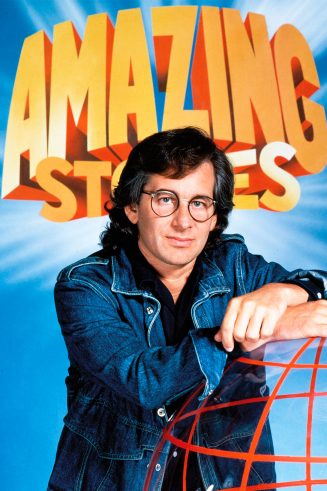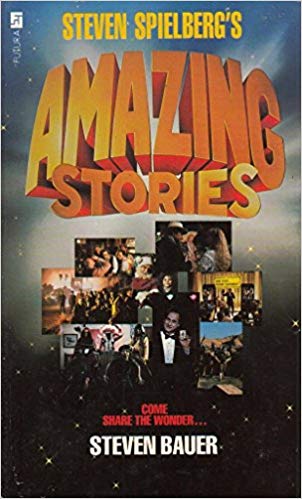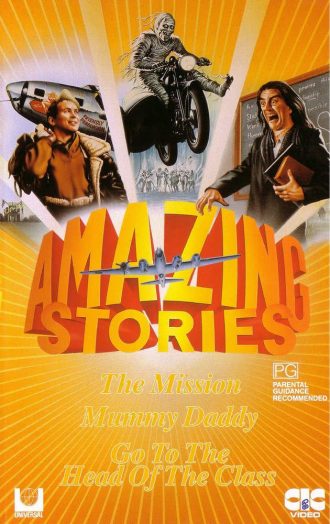 With a rebooted AMAZING STORIES debuting on Apple TV+ next week, it seems like a good time for a look back at the show’s 1985-87 inspiration. An anthology program inspired in part by the long-running magazine of the same title and executive produced by Steven Spielberg, the original AMAZING STORIES ran on NBC for two seasons before being mercifully put out of its (and our) misery.
With a rebooted AMAZING STORIES debuting on Apple TV+ next week, it seems like a good time for a look back at the show’s 1985-87 inspiration. An anthology program inspired in part by the long-running magazine of the same title and executive produced by Steven Spielberg, the original AMAZING STORIES ran on NBC for two seasons before being mercifully put out of its (and our) misery.
Peoples’ memories of the show appear to be suffused with misplaced nostalgia (the only explanation for its puzzlingly high imdb rankings), but in truth AMAZING STORIES was always a loser. This is from one who, as a TV-addicted kid at the time of its initial airing, was among the target audience. Amid the glut of horror/sci fi themed anthology programs of the mid to late eighties AMAZING STORIES always seemed the nerdiest and most out-of-touch. That was a surprise coming from Spielberg, who at the time was known for having his pulse on the finger of popular culture; here we saw a different, more old-mannish side, as reflected in the fact that so many of the episodes were headlined by old men pining away for the good old days.
The program showed up at a time when Spielberg, no longer content with just directing movies, was attempting to establish a brand name. Anyone looking for a definition of the term “Spielbergian” need only check out any of the many mid-to-late eighties movies he executive produced—GREMLINS, THE GOONIES, BACK TO THE FUTURE, YOUNG SHERLOCK HOLMES, BATTERIES NOT INCLUDED, etc.—as well as nearly any episode of AMAZING STORIES, the vast majority of which carried a “Story By Steven Spielberg” credit. The program, in fact, served as (in Spielberg’s own words) an “elephant burial ground for ideas that will never make it to the movie screen because they are just too short form.”
Clichéd and uninspiring are further adjectives I’d assign those ideas, which tended to unspool like third rate TWILIGHT ZONE cast-offs—a connection made explicit by the hiring of one THE TWILIGHT ZONE’S primary movers and shakers, the late Richard Matheson, as a story consultant. Matheson, however, didn’t hold back on his opinion of the program, bluntly stating that “there were not enough interesting or involving stories on AMAZING STORIES.”
That didn’t stop NBC from going all out on the series, splashing out $1 million for each half hour episode and a  hugely expensive opening sequence featuring bombastic John Williams theme music and then state of the art computer animation (which looks pretty cheesy now). Quite a few a few top-flight directors were recruited, including Martin Scorsese, Clint Eastwood, Irvin Kershner, Robert Zemeckis, Joe Dante and Tobe Hooper (near the end of his life Orson Welles is said to have asked “Why can’t I direct an AMAZING STORIES? Everybody else is…”). There were even a pair of tie-in paperbacks by Steven Bauer, who provided prose renderings of all the first season’s episodes. Those things, alas, didn’t help the ratings, which were consistently low; the sole reason the program got a second season was because (you guessed it) of the iconic name behind it.
hugely expensive opening sequence featuring bombastic John Williams theme music and then state of the art computer animation (which looks pretty cheesy now). Quite a few a few top-flight directors were recruited, including Martin Scorsese, Clint Eastwood, Irvin Kershner, Robert Zemeckis, Joe Dante and Tobe Hooper (near the end of his life Orson Welles is said to have asked “Why can’t I direct an AMAZING STORIES? Everybody else is…”). There were even a pair of tie-in paperbacks by Steven Bauer, who provided prose renderings of all the first season’s episodes. Those things, alas, didn’t help the ratings, which were consistently low; the sole reason the program got a second season was because (you guessed it) of the iconic name behind it.
Season one was kicked off by “Ghost Train,” an hour long episode directed by Spielberg himself. It provided an adequate preview of what was to come in its overblown special effects (which failed to impress on the small screen) and underwritten narrative about an old man (Roberts Blossom) awaiting the arrival of the eponymous train to take him away; that, it transpires, is just what happens, with the ghost train eventually crashing through the living room of a house amid a great deal of photogenic destruction. Spielberg also directed the WWII set “The Mission,” another ambitious hour long offering whose reductivist narrative was summed up by Matheson thusly: “they spent all this money on “The Mission,” they had a great cast, and it was all based on this guy drawing a wheel!”
Season one’s other episodes included “Alamo Jobe,” which has a riveting premise involving a fighter (Kelly Reno) at the Battle of the Alamo transported forward in time to present-day Texas, but goes nowhere. The same is true of “Mr. Magic,” in which an ancient magician (Sid Caesar) deals with magic cards, and the Martin Scorsese directed “Mirror, Mirror,” about a guy (Sam Waterston) who sees a demon every time he looks in a mirror. There was also “The Sitter,” about a babysitter (Mabel King) using voodoo to reign in some bratty kids, “Remote Control Man,” a message-laden goof about a schlub (Sydney Lassik) who watches too much TV, and the Clint Eastwood directed “Vanessa in the Garden,” a sentimental bore about a grief-stricken artist (Harvey Keitel) and the ghost of his fiancée (Sondra Locke).
Even farther down on the quality scale are the vomitus weepie “Dorothy and Ben,” in which an elderly black man (the late Ben Seneca) sacrifices himself to save the life of white girl (Natalie Gregory) in a coma (the Twitterati would doubtless have plenty to say about the racial dynamics presented there), and “Gather Ye Acorns,” a completely misguided account of a gnome (the late David Rappaport) who convinces a young man (Mark Hamill) to forego worldly responsibilities and hang onto his old comics and collectibles because “The World Needs More Dreamers.”
Season two was supposed to be stronger. After NBC head Brandon Taritkoff reportedly dubbed the series “too childish” Spielberg resolved that “the silly factor will be seriously minimized,” yet the second batch of AMAZING STORIES for the most part offered more of the same. Spielberg once again provided story outlines for the majority of season two’s episodes, which once again tended toward the overproduced and under-conceived.
 Nonetheless, there were some interesting entries. The Joan Darling directed “What If…?,” from a script by Spielberg’s sister Anne, was one such tale, an eerie depiction of a young boy (Jake Hart) who feels out of place in the sterile and uncaring environment in which he finds himself. For much of its runtime “What If…?” plays like an avant-garde film, although it comes to an unsatisfying conclusion.
Nonetheless, there were some interesting entries. The Joan Darling directed “What If…?,” from a script by Spielberg’s sister Anne, was one such tale, an eerie depiction of a young boy (Jake Hart) who feels out of place in the sterile and uncaring environment in which he finds himself. For much of its runtime “What If…?” plays like an avant-garde film, although it comes to an unsatisfying conclusion.
Another (semi-) worthy episode was “Such Interesting Neighbors,” which was based not on a Spielberg idea but Charles Finney’s 1951 tale of the same name about a family man who discovers that his next door neighbors are actually time travelers from the future. Adam Ant plays one of the latter characters in an episode that for all its virtues takes too many liberties with the original story, which was notable for its subtlety—an attribute completely foreign to AMAZING STORIES’s more-is-more orientation.
Then there was the series’ most famous episode, the Brad Bird helmed cartoon wonder “Family Dog.” This one, which served as a sort-of pilot for a short-lived Spielberg produced TV series, is notable for its behind-the-scenes talent, which in addition to Bird included a young Tim Burton as an animation designer, and the fact that its unapologetically cynical worldview, expressed in a mordantly hilarious depiction of a dog whose suburban owners despise it, is diametrically opposed to the saccharine air of the rest of the series. For that reason alone it warrants a recommendation (it was the only AMAZING STORIES episode, in my experience, to receive any sort of chatter on the middle school playground circuit).
The majority of season two’s offerings, however, were represented by the Richard Christian Matheson scripted “Magic Saturday,” which offers a revoltingly schmaltzy take on the popular late eighties concept of a boy switching places with a much older man (although R.C. Matheson himself was evidently quite impressed with the episode, as he included the script for it in the mass market edition of his otherwise stellar anthology SCARS AND OTHER DISTINGUISHING MARKS), the Robert Zemeckis directed “Go to the Head of the Class,” a comedic inversion on THE LEGEND OF SLEEPY HOLLOW taken up largely with a young man (Scott Coffey) being chased around by his headless teacher (Christopher Lloyd), and the altogether ridiculous “The 21-Inch Sun,” starring Robert Townsend as a screenwriter assisted in his writing by a sentient plant—a definite example of the “silly factor” referred to by Spielberg.
Ultimately the best thing about AMAZING STORIES in my view was that it makes one appreciate just how accomplished its competing 1980s anthology programs were. Those programs included CBS’s TWLIGHT ZONE reboot (a gem) and NBC’s new ALFRED HITCHOCK PRESENTS (worth it for the season one “Final Escape” episode alone), as well as the cable TV offerings TALES FROM THE DARKSIDE (probably the best show of the lot) and THE RAY BRADBURY THEATER (the quality of whose source material ensured its worthiness). Variety is indeed the spice of life, meaning TV viewers with a yen for eighties anthology series don’t have to settle for AMAZING STORIES, which, in summation, sucked.
